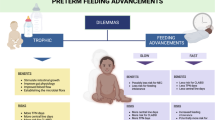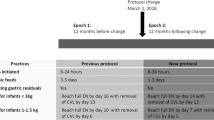Abstract
Objective:
The objective of this study was to evaluate the safety and efficacy of early amino acid (early AA) administration in very low birth weight (VLBW) infants.
Study Design:
A pre- and post-intervention study was conducted after initiating an early AA administration protocol. Clinical outcomes were collected for all VLBW infants admitted on the first day of life for 9 months before protocol initiation (standard parenteral nutrition (PN)), and 10 months after initiation of early AA.
Result:
In all, 88 infants met study criteria for standard PN, and 85 infants for early AA administration. The patient characteristics were similar between the groups. There were no differences in mortality, the day birth weight was regained, the day enteral feeds started, the duration of PN, the day full feeds achieved and weight at 32 weeks post-menstrual age. No differences were found for late sepsis, direct hyperbilirubinemia and chronic lung disease. Necrotizing enterocolitis (NEC) occurred more frequently in the early AA administration group (12 vs 1%, P=0.012).
Conclusion:
Early AA administration for VLBW infants was as efficacious as standard therapy, although increased NEC in the early AA period may have negatively affected growth and nutrition in that period.
This is a preview of subscription content, access via your institution
Access options
Subscribe to this journal
Receive 12 print issues and online access
$259.00 per year
only $21.58 per issue
Buy this article
- Purchase on Springer Link
- Instant access to full article PDF
Prices may be subject to local taxes which are calculated during checkout

Similar content being viewed by others
References
Denne SC, Poindexter BB . Evidence supporting early nutritional support with parenteral amino acid infusion. Semin Perinatol 2007; 31 (2): 56–60.
Kashyap S . Is the early and aggressive administration of protein to very low birth weight infants safe and efficacious? Curr Opin Pediatr 2008; 20 (2): 132–136.
Kotsopoulos K, Benadiba-Torch A, Cuddy A, Shah PS . Safety and efficacy of early amino acids in preterm <28 weeks gestation: prospective observational comparison. J Perinatol 2006; 26 (12): 749–754.
Clark RH, Thomas P, Peabody J . Extrauterine growth restriction remains a serious problem in prematurely born neonates. Pediatrics 2003; 111 (5 Pt 1): 986–990.
Embleton NE, Pang N, Cooke RJ . Postnatal malnutrition and growth retardation: an inevitable consequence of current recommendations in preterm infants? Pediatrics 2001; 107 (2): 270–273.
Berry MA, Abrahamowicz M, Usher RH . Factors associated with growth of extremely premature infants during initial hospitalization. Pediatrics 1997; 100 (4): 640–646.
Levitsky DA, Strupp BJ . Malnutrition and the brain: changing concepts, changing concerns. J Nutr 1995; 125 (8 Suppl): 2212S–2220S.
Grantham-McGregor S . A review of studies of the effect of severe malnutrition on mental development. J Nutr 1995; 125 (8 Suppl): 2233S–2238S.
Dobbing J . Nutritional growth restriction and the nervous system. In: Davidson AN, Thompson RHS (eds). The Molecular Bases of Neuropathology 1981, pp 231–233.
Ehrenkranz RA, Dusick AM, Vohr BR, Wright LL, Wrage LA, Poole WK . Growth in the neonatal intensive care unit influences neurodevelopmental and growth outcomes of extremely low birth weight infants. Pediatrics 2006; 117 (4): 1253–1261.
te Braake FW, van den Akker CH, Wattimena DJ, Huijmans JG, van Goudoever JB . Amino acid administration to premature infants directly after birth. J Pediatr 2005; 147 (4): 457–461.
Ziegler EE, O'Donnell AM, Nelson SE, Fomon SJ . Body composition of the reference fetus. Growth 1976; 40 (4): 329–341.
Ibrahim HM, Jeroudi MA, Baier RJ, Dhanireddy R, Krouskop RW . Aggressive early total parental nutrition in low-birth-weight infants. J Perinatol 2004; 24 (8): 482–486.
Adamkin DH . Pragmatic approach to in-hospital nutrition in high-risk neonates. J Perinatol 2005; 25 (Suppl 2): S7–S11.
Thureen PJ, Hay Jr WW . Early aggressive nutrition in preterm infants. Semin Neonatol 2001; 6 (5): 403–415.
Thureen PJ . Early aggressive nutrition in the neonate. Pediatr Rev 1999; 20 (9): e45–e55.
Denne SC . Protein and energy requirements in preterm infants. Semin Neonatol 2001; 6 (5): 377–382.
Poindexter BB, Denne SC . Protein needs of the preterm infant. NeoReviews 2003; 4: e52–e59.
Adamkin DH . Nutritional management of the very low-birthweight infant. NeoReviews 2006; 7: e602–e607.
Rivera Jr A, Bell EF, Bier DM . Effect of intravenous amino acids on protein metabolism of preterm infants during the first three days of life. Pediatr Res 1993; 33 (2): 106–111.
Van Goudoever JB, Colen T, Wattimena JL, Huijmans JG, Carnielli VP, Sauer PJ . Immediate commencement of amino acid supplementation in preterm infants: effect on serum amino acid concentrations and protein kinetics on the first day of life. J Pediatr 1995; 127 (3): 458–465.
van Lingen RA, van Goudoever JB, Luijendijk IH, Wattimena JL, Sauer PJ . Effects of early amino acid administration during total parenteral nutrition on protein metabolism in pre-term infants. Clin Sci (Lond) 1992; 82 (2): 199–203.
Ernst KD, Radmacher PG, Rafail ST, Adamkin DH . Postnatal malnutrition of extremely low birth-weight infants with catch-up growth postdischarge. J Perinatol 2003; 23 (6): 477–482.
Ehrenkranz RA, Younes N, Lemons JA, Fanaroff AA, Donovan EF, Wright LL et al. Longitudinal growth of hospitalized very low birth weight infants. Pediatrics 1999; 104 (2 Pt 1): 280–289.
Gill A, Yu VY, Bajuk B, Astbury J . Postnatal growth in infants born before 30 weeks' gestation. Arch Dis Child 1986; 61 (6): 549–553.
Lubchenco LO, Hansman C, Dressler M, Boyd E . Intrauterine growth as estimated from liveborn birth-weight data at 24 to 42 weeks of gestation. Pediatrics 1963; 32: 793–800.
Sparks JW . Human intrauterine growth and nutrient accretion. Semin Perinatol 1984; 8 (2): 74–93.
Jackson AA, Shaw JC, Barber A, Golden MH . Nitrogen metabolism in preterm infants fed human donor breast milk: the possible essentiality of glycine. Pediatr Res 1981; 15 (11): 1454–1461.
Lubchenco LO, Hansman C, Boyd E . Intrauterine growth in length and head circumference as estimated from live births at gestational ages from 26 to 42 weeks. Pediatrics 1966; 37 (3): 403–408.
Fenton TR, McMillan DD, Sauve RS . Nutrition and growth analysis of very low birth weight infants. Pediatrics 1990; 86 (3): 378–383.
Martin CR, Brown YF, Ehrenkranz RA, O'Shea TM, Allred EN, Belfort MB et al. Nutritional practices and growth velocity in the first month of life in extremely premature infants. Pediatrics 2009; 124 (2): 649–657.
Stephens BE, Walden RV, Gargus RA, Tucker R, McKinley L, Mance M et al. First-week protein and energy intakes are associated with 18-month developmental outcomes in extremely low birth weight infants. Pediatrics 2009; 123 (5): 1337–1343.
Cooke RJ, Ainsworth SB, Fenton AC . Postnatal growth retardation: a universal problem in preterm infants. Arch Dis Child Fetal Neonatal Ed 2004; 89 (5): F428–F430.
Barker DJ . The fetal and infant origins of adult disease. BMJ 1990; 301 (6761): 1111.
Author information
Authors and Affiliations
Corresponding author
Ethics declarations
Competing interests
The authors declare no conflict of interest.
Rights and permissions
About this article
Cite this article
Trintis, J., Donohue, P. & Aucott, S. Outcomes of early parenteral nutrition for premature infants. J Perinatol 30, 403–407 (2010). https://doi.org/10.1038/jp.2009.173
Received:
Revised:
Accepted:
Published:
Issue Date:
DOI: https://doi.org/10.1038/jp.2009.173



